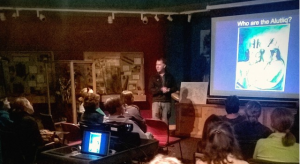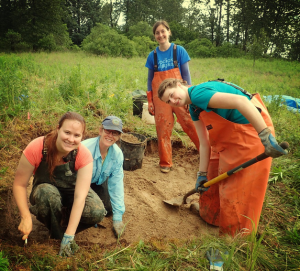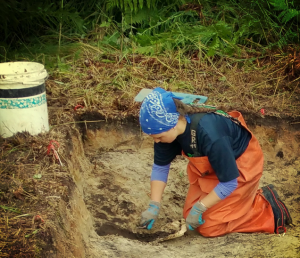Please welcome Rachel Gill, a senior archaeology major at Boston University, who will be blogging about our adventures on Kodiak!
On a small island just a 90 minute flight from Anchorage, Alaska, Kodiak has been home to the Alutiiq people for nearly 8,000 years.
Much of the landscape remains touched only by time and weather; mountains and trees tower above bays shrouded in mist and clouds almost constantly loom in the distance. And nearly all of Native American prehistory, from the ancient Ocean Bay period to the more recent Russian colonization, lies somewhere beneath the soil. With more than 1,300 known sites across the archipelago and many more left to be unearthed, modern Alutiiqs now have ways to not only answer the questions they have about their own past due to aggressive and brutal western colonization, but connect with their ancient ancestors on a personal level thanks to Community Archaeology.
Pioneered by Alutiiq Museum archaeologists in 1997, because of native curiosity and the escalating fear of site erosion and disturbance (accidental or intentional), Blisky was the very first site to be excavated by community volunteers. And with over 3,500 artifacts brought to the surface and studied, in the spring of 1998 the Community Archaeology project was born.
Nearly 17 years later, Community Archaeology has hosted at least one month-long excavation every summer. (High school and college age participants may also get course credit for the excavation as I am experiencing personally and the museum also employs a few interns every year to help with the project.)
Ultimately the goal is to understand how these ancient people used the land to work, live, exist. Through time, the settlement patterns of the Alutiiq, their tools, and priorities change. The daunting question is to figure out how, when, and why these patterns and tools shifted and altered.

Volunteers and students start by attending a small introductory session to explain the basics of excavation, where the site is located, and why they are interested in digging there at all. This year, just like last, we’re excavating a few grids at the Kashevaroff site near Salonie Creek where they found a house in excavations past. (Don’t worry, there won’t be a quiz.) College students and directors of the project start the Friday before, surveying the site and setting up grid points for the volunteers to excavate in the coming weeks.

Day 1 always brings two words every Alaskan archaeologist knows will only bring fatigue and muscle pain: sod busting. An unfortunately necessary evil because we have to remove the sod and a layer of volcanic ash before we can even think about reaching the goodies underneath.

The rest of the dig brings the removal of layer after painstaking layer with a mucky dustpan and muddy trowel. Artifact recovery never moves at a steady pace; there are days where someone can’t go five minutes without finding something new and interesting and exciting; and then there are days where it takes hours to find anything more than a rather disappointing pebble amidst all the mud.

But in the end, no matter the quantity of artifacts recovered or the sheer volume of dirt moved (which, believe me, can be immense), the community interest and the desire to preserve a Native history that was nearly wiped out by Westerners is what drives the museum and the project.
As perfectly stated by Patrick Saltonstall and Amy Steffian, two of the Alutiiq Museum’s archaeologists: “Archaeology is much more than an academic discipline… archaeology is a practice with profound social consequences.” Everything we find as archaeologists is just a piece of the vast history of the human race. It can change entire views of ancient cultures and people and cause a stir around the world. Community Archaeology seeks to let the local people be a part of this incredible unveiling of the past.
Even they have to be covered in mud to do it.

